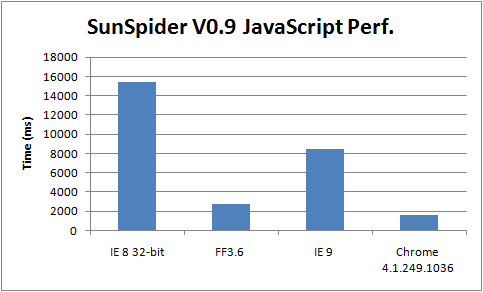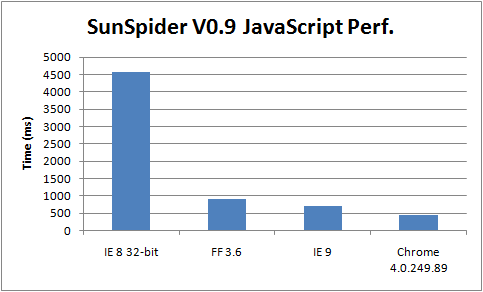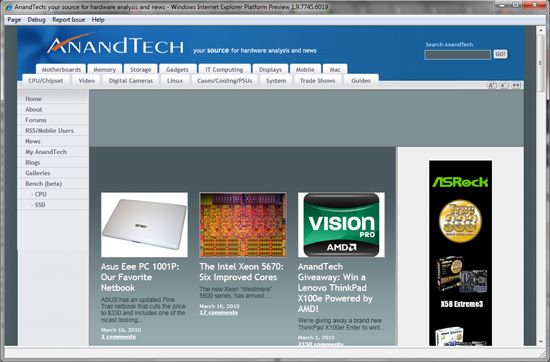Internet Explorer 9 Platform Preview: Investigated
by Brian Klug on March 17, 2010 11:44 AM EST- Posted in
- Trade Shows
Yesterday, Microsoft launched the Internet Explorer 9 Platform Preview at MIX10. Though the current release of the platform preview is very rough around the edges, it promises to bring Internet Explorer into full web standards compliance, partially erasing the web-standard scourge that IE 6 still scandalizes on the internet. Some of the biggest applause-drawing moments happened when IE team members themselves mentioned how important rapid migration away from IE 6 is. What that means is W3C compliance is a very real and important goal, including complete support for HTML5, CSS3, SVG, XHTML, and H.264/MPEG4 HTML5 <video> playback. At the same time, Microsoft hopes to gain valuable insight from web developers about what direction the IE team should take.
JavaScript Performance
But some of the strongest focus of the IE9 platform preview is targeted towards raising the so-called "glass ceiling" on web browsing performance. Microsoft hopes to drive that performance cap higher half through GPU-acceleration for rendering 2D, 3D, and HTML <video> content, and the other half through an entirely new multithreaded JavaScript engine codenamed "Chakra."
Microsoft provided a number of slides comparing JavaScript performance of IE 9 in its current preview, and claims it's at party with Firefox 3.6 and nearly as good as Chrome 4.0.249.89 (stable) tested with SunSpider 0.9:

I initially attempted to validate and reproduce these results on my Latitude XT, and saw something very strange:

I ran and re-ran the test several times; for whatever reason, IE 9 Platform Preview doesn't like my Latitude XT running Windows 7 with a Core 2 Duo U7600 with 3 GB of RAM. Puzzled by the discrepancy, I ran the same tests on another computer running Windows Server 2008 R2 with a Celeron E3400 2.6 GHz with 4 GB of RAM. This CPU is essentially a Core 2 Duo with just 1 MB of L2 cache.
The results were much better:

I realize there's a slight discrepancy between the builds of Chrome on each test bed, however the JavaScript engine itself remains relatively unchanged; performance is on a nearly identical level. Obviously, something on the notebook hinders IE 9's performance dramatically.
Another interesting benchmark we considered was how well IE 9's codename "Chakra" JavaScript engine scales per thread. I was in the process of firing up IE 9 platform preview again to evaluate SunSpider results with different processor affinities toggled, when I was greeted with this:

Uh oh
Considering how early of a preview this is, it's completely understandable that not everything is working properly across every system configuration. I've submitted feedback and a bug report, and plan on continuing to investigate the discrepancy.
It's important to note that IE9 in its current form isn't really a beta, it's somewhere between an alpha and a beta. Microsoft describes this release as "just enough of a slice of the browser" to both let web developers and designers try the new rendering engine, flesh out what HTML5 markup is most favored, and start to get feedback flowing. There's nothing in the way of a back button, tabs, address bar, or favorites. It's just a barebones Trident-wrapper that gives a relatively complete perspective on the direction Microsoft hopes to take IE. They promise to adhere to a strict eight-week schedule for updating the platform with improvements, addressing issues at each step, and increasing their Acid3 score every step of the way. More on that later.
Initial Perspective
But enough with that, let's take a look at it by loading anandtech.com:

It throws an error about scripts; again, there are bound to be problems given the massive rewrite of the JavaScript engine, but otherwise it seems to run. Other than that, yeah, the UI exactly what you see: totally bare-bones. Control-O for opening an address, and F10 for home will get a lot of use if you decide to try this preview out. As mentioned earlier, there's no back button or keyboard shortcut for it at all.










60 Comments
View All Comments
hakime - Wednesday, March 17, 2010 - link
"For quite some time, the bar has been steadily raised in the JavaScript engine domain by continual competing releases of Chrome, Firefox, and Opera."This is a huge distortion of the reality for not mentioning Safari. Safari was the first in the javascript performance race, Firefox is still well behind Safari and Opera came back to the game just recently with version 10.5.
"Next up is Safari 4.0.4. Image quality of the scaled logos in the extreme back and far front is likewise very good, however Safari too struggles to render more than 2-3 FPS.......
"but unsurprising given the poor performance of its WebKit brethren, Safari."
Well I have to put some precessions in this. Webkit (hence Safari for windows) for some reason or another does not support GPU acceleration on windows. It does on Mac OS X. I am running the exact same demo with 36 images on my macbook pro with a GeForce 8600M GT and I am getting something 59-60 fps with minimum load on my cpu cores. And the image quality is very good, I think well better than IE9. So what I want to say is that IE9 is not the only browser capable of achieving this level of performance in the market, Safari on mac does, it does it for already quite a while. The difference is that Safari on mac is a available today and IE9 is not and won't be for months. In other words, IE9 is catching up with the state of the art available today.
"In addition, they showcased the subpixel-rendering capabilities that they can leverage that other browsers still lack."
And what? The test "Text Size Animated" from the IE9 test drive runs very nicely on with Safari on mac. Again, doing GPU powered smooth animation of text with sub-pixel positioning is not a new thing.
nerdtalker - Thursday, March 18, 2010 - link
I think there were two reasons that I treated Safari the way I did; primarily because IE 9 is Windows-only at this point, and it's difficult to compare validly across operating systems. It's completely obvious that we need to a longer, even more comprehensive comparison of the state of browsers. Just bear in mind that this article was prepared with an angle in mind of it being more of a validation of claims than a comprehensive roundup. My resources were limited (only had my Latitude XT) and the time constraint was virtually hours.That said, I'm very interested in investigating both WebGL, acceleration between Windows and OS X, and finally some of the later development builds of each browser. There's some ambiguity in the GPU requirements thus far for IE 9 hardware acceleration that I'm trying to clear up. Furthermore, I'd like to try all the latest nightly builds or whatever is suitable; it's only fair to compare bleeding edge against bleeding edge.
I really really appreciate the feedback though, I'm getting some awesome ideas for a comprehensive roundup do-over. ;) It's definitely coming.
Cheers,
Brian Klug
hakime - Thursday, March 18, 2010 - link
"primarily because IE 9 is Windows-only at this point, and it's difficult to compare validly across operating systems."Yes sure, I am ok with that. But this does not mean that one can't say that other platforms have already advanced the state of the art in GPU accelerated web moden content and that IE is following the trend. In our days, windows/IE/Microsoft, and you surely agree, are not the center of the world when it comes to web/web browser innovations.
taltamir - Thursday, March 18, 2010 - link
when other platforms get double digit market share then we will talk, until then "everyone" [sic] uses windows.nerdtalker - Thursday, March 18, 2010 - link
I totally agree; GPU acceleration isn't entirely IE 9 centric in this circumstance, nor is the innovation entirely from IE 9. That said, they've acknowledged the huge performance gap between IE 8 and other modern browsers (WebKit and Gecko based) and are promising to do something about it. Illustrating that was my primary focus here, even if it did come off sounding a bit to IE-fanboyish.Rest assured we're definitely putting something together that's comprehensive comparing WebGL, WDDM (IE 9) and OS X (Quartz Compositing). The big problem was that I was on my relatively underpowered tablet (with an obsolete integrated ATI GPU) and couldn't really get the full gamut of GPU acceleration working.
Seriously though, I really appreciate the tips and suggestions. This is still extremely valuable for discovering what you all would like tested (so I don't forget anything ;) )
Cheers,
Brian Klug
mechBgon - Thursday, March 18, 2010 - link
"This is still extremely valuable for discovering what you all would like tested (so I don't forget anything ;) )"I don't know if you have any experience as a sysadmin, but central manageability is a biggie, and often forgotten by the home/SOHO press. Preconfigure, deploy, audit, update, reconfigure, enforce and lock down any number of browser installations, over the network, from your own office, whether the users want to cooperate or not? Yeah, IE can do that, since IE 5.01. Anyone else...?
*crickets*
hakime - Thursday, March 18, 2010 - link
Fair enough!My concern is that the way it is presented in your text makes somehow believe that IE9 is the best performer in GPU acceleration out there or even that it is the only one that does GPU acceleration. It is not the case at all, you agree I presume.
By the way there is one little mistake in your text
"Next, Firefox 3.6. Performance here is dramatically better than Safari or IE 6"
IE 6 -> IE 8.
AnandThenMan - Wednesday, March 17, 2010 - link
Anandtech.com needs to consider cleaning up their own code before they start testing new browsers for page rendering. Not defending IE in anyway it will always be a scourge on the Internet IMO, but 124+ errors on the homepage is not exactly a good showing.ncage - Wednesday, March 17, 2010 - link
I'll take usability over these performance zealots any day. While i don't use ie8 a lot i found it to be acceptable in most cases. The reason i don't use ie is two fold:1) its the biggest target for malware writers.
2) (again usability) Firefox Add-On libraries.
Firefox isn't that fastest but its has the greatest functionality because of the extensive add-ons. I'll tell you on all my computers Chrome is by fast the fastest and yes they have addons now but the community is not nearly as mature right now. I think what IE team should work on along with performance would be to add a .Net library that would make developing quality add-ins for IE easy. Until they do that i will stick with firefox (its fast enough).
deeceefar2 - Wednesday, March 17, 2010 - link
Notably absent is any mention of webgl. Though I didn't expect to see them mention it. I think it is important to note they are the only browser with no announced support of webgl. The standard is still in flux, but with no announced support and at least a 1 year lead time on a newer version of internet explorer, and who knows how long on the actual adoption curve. It just pushes web standards evolution back further.Webgl being based on open gl es 2.0 should make it possible to write a game or 3d browser app that works the same on all web platforms from all browsers except IE and all phones. Would be a shame to lose such an advancement because of IE.